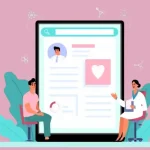
5 Smart Ideas For Integrating QR Codes In Patient Feedback Collection
Gathering patient feedback is essential for improving healthcare services and ensuring satisfaction. Traditional methods can be slow and often yield low response rates. QR codes offer a modern, efficient way to collect feedback.
By integrating QR codes into various patient touchpoints, you can streamline the feedback process and enhance engagement. This article explores five smart strategies for leveraging QR codes to improve patient feedback collection and ultimately boost service quality.
Integrating QR Codes In Patient Feedback Collection
Integrating QR codes in patient feedback collection is a modern and efficient way to gather valuable insights from patients. Below are five key strategies:
1. QR Codes On Appointment Cards
Adding QR codes to appointment cards provides patients with a quick and easy way to access feedback forms after their visit, ensuring they remember to provide their insights.
Patients often forget to provide feedback after leaving the healthcare facility. By integrating QR codes on appointment cards, you can remind patients to share their experiences, enhancing the likelihood of receiving valuable feedback.
2. Place QR Codes In Waiting Areas
By placing QR codes in waiting areas, healthcare facilities can provide patients with a simple and accessible way to provide feedback while they wait for their appointments.
Patients often have some idle time in waiting areas, making it an ideal opportunity for them to share their experiences. Placing QR codes in these areas can encourage patients to provide valuable feedback without feeling rushed or pressured.
3. Use QR Codes In Email Follow-Ups
Incorporating QR codes in email follow-ups offers patients a straightforward method to access feedback forms, enhancing response rates and simplifying the feedback process.
Email follow-ups are a common practice in patient feedback collection. By including QR codes in these emails, patients can easily access feedback forms with a quick scan, eliminating the need to click through multiple links.
4. Display QR Codes On Posters And Flyers
Posters and flyers with QR codes placed in high-traffic areas such as hospital entrances, elevators, and restrooms can capture patients’ attention and encourage feedback.
High-traffic areas are excellent locations for QR codes as they ensure maximum visibility. Patients passing by these areas can quickly scan the codes and provide feedback on their experiences.
5. Incorporate QR Codes In Patient Discharge Documents
Including QR codes in patient discharge documents allows patients to easily access feedback forms once they are home, providing insights into their overall experience and recovery process.
Discharge documents are critical for patients as they contain important information about their post-treatment care. Adding QR codes to these documents ensures that patients can conveniently provide feedback once they are settled at home.
Conclusion
Integrating QR codes in patient feedback collection is a smart and efficient way to gather valuable insights from patients.
By strategically placing QR codes in waiting areas, on appointment cards, in email follow-ups, on posters, and in discharge documents, healthcare facilities can enhance the feedback process, leading to improved services and patient satisfaction.
Frequently Asked Questions
How Do QR Codes Improve Patient Feedback Collection?
QR codes streamline the feedback process by providing patients with an easy and convenient way to access feedback forms, leading to higher response rates and more comprehensive data.
Are QR Codes Secure For Collecting Patient Feedback?
Yes, QR codes can be used securely for patient feedback collection. It is essential to ensure that the feedback forms are hosted on secure platforms to protect patient information.
Can QR Codes Be Customized For Different Departments In A Healthcare Facility?
Yes, QR codes can be customized for specific departments, allowing for targeted feedback collection and more detailed insights into each department’s performance.
What Are The Costs Associated With Implementing QR Codes For Patient Feedback?
The costs are generally low, as generating and printing QR codes is inexpensive. The main investment is in setting up and maintaining the online feedback forms.
How Can I Track The Effectiveness Of QR Codes In Collecting Patient Feedback?
You can track the effectiveness by monitoring the response rates and analyzing the feedback received. Most QR code generators provide analytics to help you measure their performance.
Enhance Patient Care and NABH Compliance with LazyMonkey
LazyMonkey is your all-in-one solution for improving patient care, retaining more patients, and meeting NABH standards. Our powerful QR-based feedback tool enables you to capture real-time insights from patient feedback, discharge surveys, staff and doctor evaluations, and clinical research, while also streamlining inter-departmental communication.
Transform your healthcare facility today - reach out to us at hello@lazymonkey.in, or request a demo here!
Elevate Your Restaurant Experience with LazyMonkey
LazyMonkey’s QR-based feedback system helps you gather real-time insights from customers, track satisfaction levels, and enhance the dining experience. Get instant feedback on your menu, service, and ambience, and make data-driven improvements to boost repeat customers and reviews.
Improve your restaurant today – reach out to us at hello@lazymonkey.in, or request a demo here!
Empower Student Engagement and Campus Improvement with LazyMonkey
LazyMonkey offers a seamless way to gather student feedback, track satisfaction, and enhance campus life. From course evaluations to dorm feedback, our QR-based solution makes it easy to capture valuable insights and improve student retention.
Upgrade your university experience – contact us at hello@lazymonkey.in, or request a demo here!
Streamline Feedback and Drive Performance Across Your Enterprise/Franchise with LazyMonkey
Whether you manage one or multiple locations, LazyMonkey’s QR-based feedback system helps you gather real-time employee and customer feedback. Improve operational efficiency, track satisfaction, and make data-driven decisions to enhance brand consistency and growth.
Transform your franchise today – reach out to us at hello@lazymonkey.in, or request a demo here!
Enhance Customer Satisfaction and Service Standards in Banking with LazyMonkey
LazyMonkey empowers banks to capture real-time feedback from clients across branches. Improve customer experience, assess service quality, and ensure regulatory compliance with our QR-based solution, helping you retain clients and meet banking standards.
Elevate your bank’s customer care – contact us at hello@lazymonkey.in, or request a demo here!
Boost Customer Engagement and Mall Satisfaction with LazyMonkey
LazyMonkey’s QR-based feedback tool enables you to collect feedback from shoppers, track satisfaction, and enhance the mall experience. Gather insights on store services, cleanliness, and entertainment to create an unmatched customer journey.














